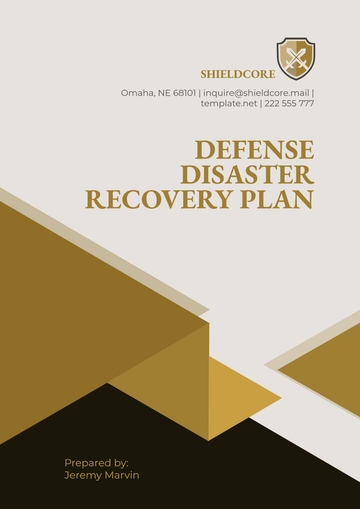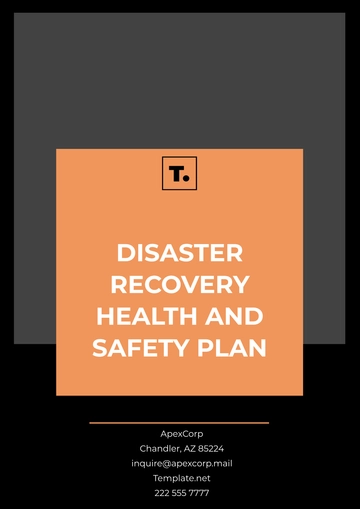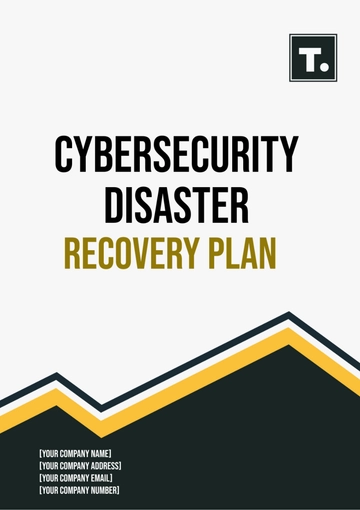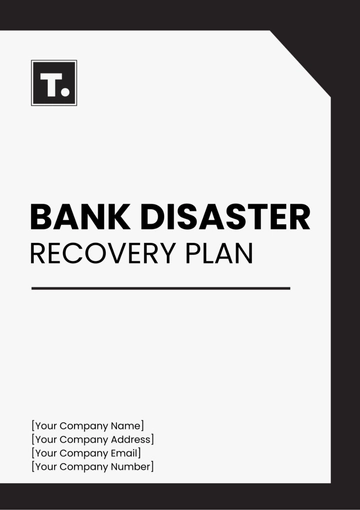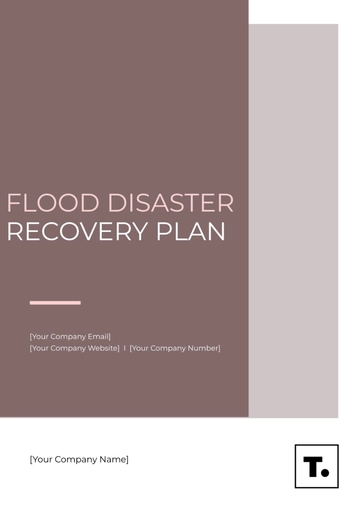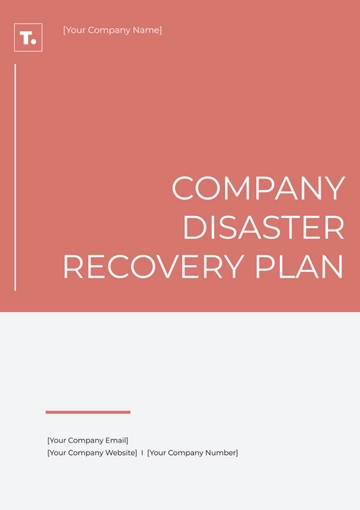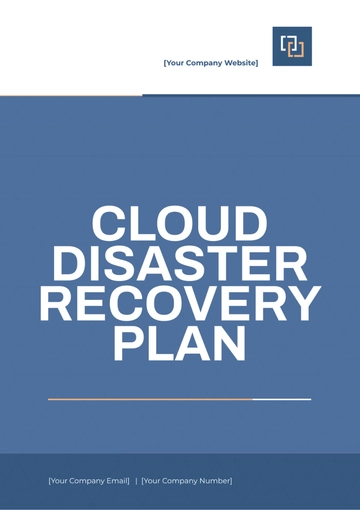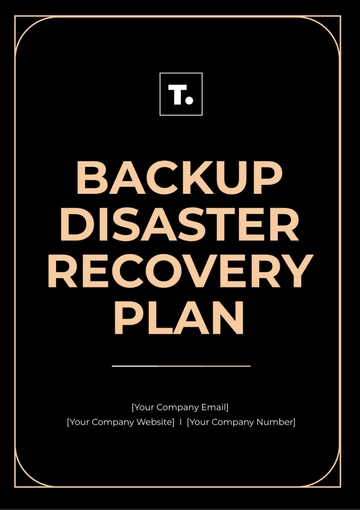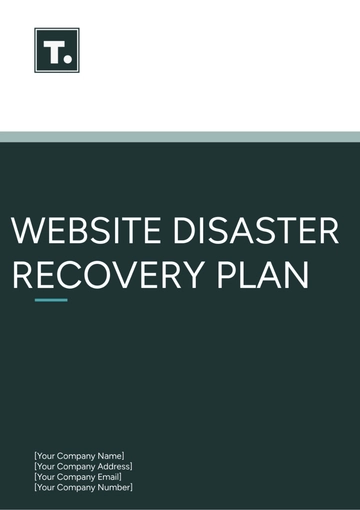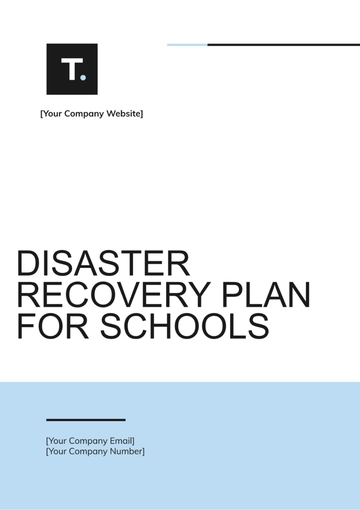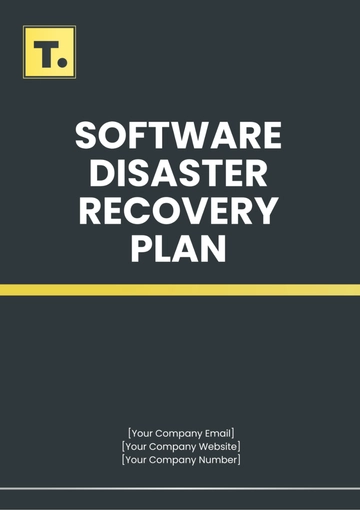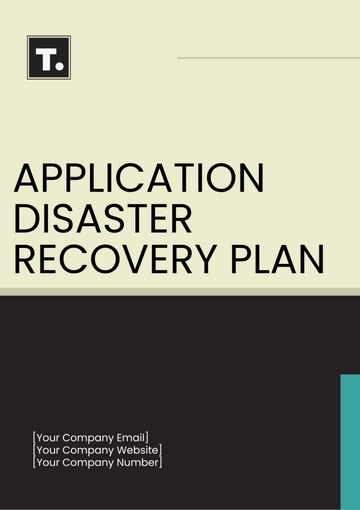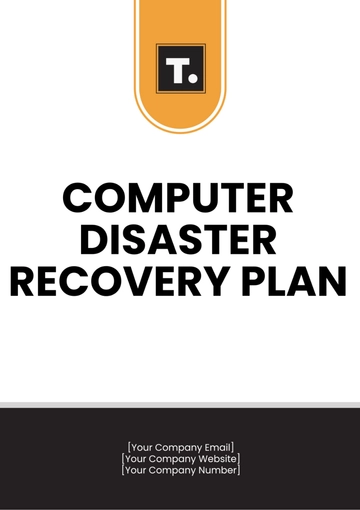Free Workplace Incident Recovery Plan
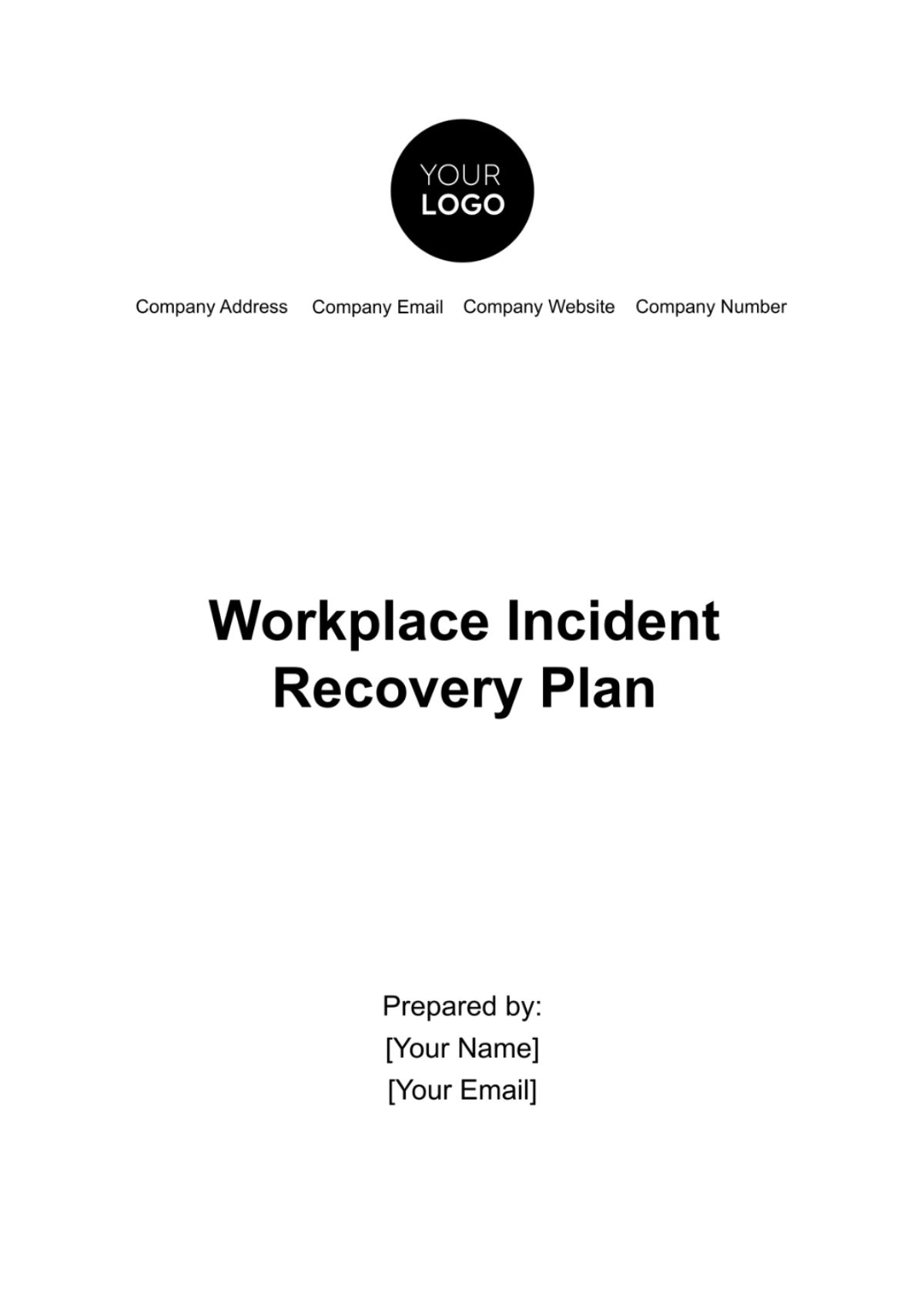
Introduction
A. Purpose
The primary purpose of this Workplace Incident Recovery Plan is to establish a structured framework for effectively responding to and recovering from workplace incidents. This plan encompasses a wide range of incidents, including but not limited to security breaches, natural disasters, equipment failures, and human errors. The goal is to minimize the impact of such incidents on our operations, assets, and employees.
B. Scope
This plan applies to all employees, contractors, and stakeholders of [Your Company Name], regardless of their location or role within the organization. It covers incidents that occur within our physical premises at [Your Company Address], as well as incidents that may impact our remote workers. The scope of this plan extends to all aspects of incident management, including prevention, detection, response, recovery, and lessons learned.
C. Document Overview
This document serves as a comprehensive guide to incident recovery within [Your Company Name]. It outlines the roles and responsibilities of the Incident Response Team, establishes procedures for incident classification, reporting, and recovery, and provides guidance on continuous improvement through post-incident analysis. Additionally, it addresses training, awareness, and testing initiatives aimed at enhancing our preparedness and response capabilities.
Incident Response Team
A. Team Roles and Responsibilities
The Incident Response Team (IRT) is a dedicated group of individuals responsible for coordinating and executing the incident recovery process. Key roles and their responsibilities include:
1. Incident Manager [Your Name]
The Incident Manager is the leader of the IRT and is responsible for overall incident coordination. This includes decision-making, resource allocation, and communication with senior management and external stakeholders.
2. Technical Lead
The Technical Lead oversees the technical aspects of incident response. This role involves assessing the technical impact of the incident, identifying vulnerabilities, and coordinating with IT and security teams to mitigate risks.
3. Communications Coordinator
The Communications Coordinator manages internal and external communications during an incident. This includes notifying affected parties, stakeholders, and the media as necessary. Clear and timely communication is critical in maintaining trust and transparency.
4. Legal Counsel
Legal Counsel provides legal guidance throughout the incident recovery process. They assess potential legal implications, regulatory requirements, and contractual obligations, ensuring that the company remains compliant and minimizes legal risks.
5. Public Relations Liaison
The Public Relations Liaison is responsible for managing media and public relations. In the event of a high-profile incident, this role ensures that the company's public image and reputation are safeguarded.
Incident Classification
A. Incident Severity Levels
Incidents within [Your Company Name] are classified into four severity levels to assess their potential impact:
1. Level 1: Critical
Definition: Incidents of utmost severity, causing significant harm to personnel, property, or operations.
Examples: Major natural disasters, cyber-attacks leading to data breaches, and life-threatening emergencies.
Response Timeframe: Immediate response is required, within minutes.
2. Level 2: High
Definition: Incidents with a substantial impact on operations, assets, or personnel.
Examples: Severe IT system failures, substantial environmental incidents, and major security breaches.
Response Timeframe: Rapid response is required, within hours.
3. Level 3: Medium
Definition: Incidents of moderate impact, affecting specific areas or functions.
Examples: Minor system disruptions, localized facility incidents, and moderate data breaches.
Response Timeframe: A timely response is required, within a business day.
4. Level 4: Low
Definition: Incidents with minimal impact, easily manageable without significant resources.
Examples: Minor equipment malfunctions, isolated incidents with no operational impact.
Response Timeframe: Response as resources permit, within a few business days.
B. Incident Categories
Incidents at [Your Company Name] fall into several categories, each with its unique characteristics and response strategies:
1. Security Incidents
Definition: Incidents related to unauthorized access, data breaches, or cyber threats.
Response: Immediate isolation of affected systems, forensic analysis, and coordination with IT security teams.
2. Natural Disaster
Definition: Incidents caused by natural events such as earthquakes, floods, or severe weather conditions.
Response: Evacuation and safety measures, facility assessments, and coordination with emergency services.
3. Technological Failures
Definition: Incidents involving hardware or software failures affecting critical systems.
Response: Technical diagnostics, system recovery, and communication with IT support teams.
4. Human Errors
Definition: Incidents resulting from unintentional mistakes or negligence by employees or contractors.
Response: Identification of root causes, corrective actions, and employee training to prevent recurrence.
Incident Reporting
A. Reporting Procedures
Timely and accurate reporting of incidents is crucial to effective response and recovery. [Your Company Name] has established the following procedures:
1. Immediate Notification
Employees must report critical incidents immediately to their immediate supervisor, who will escalate it to the Incident Manager.
2. Standard Incident Reporting
All other incidents should be reported using the company's standardized incident reporting form, available on [Your Company Website].
3. Anonymous Reporting
Anonymous reporting channels are available to encourage the reporting of sensitive or confidential incidents.
B. Incident Documentation
Comprehensive documentation of incidents is essential for analysis, reporting, and compliance. The following information should be documented for each incident:
Date and time of the incident.
Location and affected area.
Description of the incident.
Names of involved parties.
Immediate actions taken.
Impact assessment.
C. Reporting Channels
Incidents can be reported through various channels, including:
In-person reporting to a supervisor or manager.
Online incident reporting form on [Your Company Website].
Anonymous hotline or email reporting.
Direct communication with the Incident Response Team members.
Initial Response
A. Activation of the Incident Response Team
Upon receiving notification of an incident, the Incident Manager ([Your Name]) will initiate the following actions:
1. Notification
Immediately notify all members of the Incident Response Team, providing a brief overview of the incident and its severity level.
2. Resource Allocation
Assess the incident's scope and allocate necessary resources, including personnel and equipment, to address the situation effectively.
3. Incident Command Center
Establish an incident command center, equipped with communication tools and necessary documentation.
B. Primary Objectives
During the initial response phase, the primary objectives are as follows:
Life Safety
Ensure the safety of all employees, contractors, and visitors. Evacuate if necessary and provide medical attention as required.
Incident Containment
Prevent the incident from spreading or escalating. Isolate affected areas or systems to minimize further damage.
Preservation of Evidence
Preserve any potential evidence related to the incident, especially in the case of security incidents.
C. Secure the Affected Area
Depending on the nature of the incident, the following actions may be taken to secure the affected area:
Physical Security
Implement access controls to restrict entry to affected areas. This may include locking doors, using barricades, or establishing restricted zones.
Digital Security
In the case of cybersecurity incidents, isolate affected systems from the network to prevent the spread of malware or unauthorized access.
Assessment and Investigation
A. Incident Assessment
The Incident Manager, in coordination with relevant team members, will conduct a preliminary assessment to determine the following:
The nature and cause of the incident.
The extent of damage or impact.
Immediate risks and threats.
Potential legal or regulatory implications.
B. Investigation Process
If the incident requires further investigation, the following steps will be taken:
Establish Investigation Team
Appoint an investigation team led by the Technical Lead. This team will consist of subject matter experts and may involve external experts if necessary.
Evidence Collection
Collect and preserve evidence related to the incident. This includes logs, records, physical evidence, and digital evidence.
Forensic Analysis
Perform a forensic analysis of digital evidence in the case of security incidents. Identify the source of the breach and assess the extent of data compromise.
Interviews
Conduct interviews with relevant personnel involved or witnesses to the incident to gather additional information.
Root Cause Analysis
Determine the root cause(s) of the incident to prevent similar occurrences in the future.
C. Data Collection and Preservation
In the event of an incident involving data loss or compromise, strict data collection and preservation protocols will be followed, including:
Data Backups: Identify and restore data from backups where possible.
Chain of Custody: Maintain a chain of custody for all collected evidence to ensure its integrity and admissibility.
Data Recovery: Work on data recovery procedures to restore lost or corrupted data.
Communication Plan
A. Internal Communication
Effective communication within [Your Company Name] is crucial during incident recovery. The following communication strategies will be employed:
Incident Notifications
Regular updates will be provided to all employees and stakeholders through various channels such as email, internal messaging systems, and in-person briefings.
Information Sharing
Share incident-related information with relevant teams, ensuring that everyone has access to the latest updates and instructions.
Chain of Command
Maintain clear lines of communication within the Incident Response Team, specifying roles and responsibilities for disseminating information.
B. External Communication
Managing external communication is essential to maintain transparency and protect the company's reputation. The following guidelines will be followed:
Stakeholder Notification
Timely notification of external stakeholders, including customers, partners, regulatory authorities, and the media, will be coordinated by the Communications Coordinator.
Media Relations
The Public Relations Liaison will handle all media inquiries and ensure that accurate and approved information is released to the public.
Regulatory Reporting
Comply with all legal and regulatory reporting requirements, working closely with Legal Counsel to ensure accurate submissions.
Containment and Mitigation
A. Isolate Affected Systems
Containment of the incident is critical to prevent further damage or data loss. The following steps will be taken:
Network Isolation: Disconnect affected systems from the network to prevent the spread of malware or unauthorized access.
Quarantine: Quarantine infected or compromised devices to prevent them from affecting other parts of the network.
Access Controls: Implement strict access controls on affected areas or systems to limit access to authorized personnel only.
B. Prevent Further Damage
To prevent further damage or loss, the following measures will be initiated:
Patch and Update: Apply patches or updates to systems to close vulnerabilities that may have been exploited during the incident.
Password Resets: Reset passwords for affected accounts and systems to prevent unauthorized access.
Security Audits: Conduct security audits to identify and address weaknesses in the security infrastructure.
C. Recovery Measures
Initiate recovery measures to restore affected systems and operations:
System Restoration: Restore affected systems from backups, ensuring data integrity and security.
Data Recovery: Recover lost or corrupted data using backups or data recovery techniques.
Testing: Conduct thorough testing to ensure that systems are fully operational and secure before they are reintroduced into the production environment.
Recovery
A. Restoration of Systems
The recovery phase focuses on restoring normal operations as quickly as possible. This involves:
Prioritization
Identify critical systems and applications that need to be restored first to minimize downtime and impact on business operations.
Backup Restoration
Restore data and systems from backups, ensuring that data integrity is maintained. Verification of backups should be part of this process.
Testing
Conduct rigorous testing of restored systems to ensure they are functioning correctly and securely. This includes both functionality and security testing.
Parallel Operations
In some cases, parallel operations may be established to ensure a smooth transition back to normal operations. This involves running both restored systems and backup systems simultaneously until confidence in the restored systems is established.
B. Data Recovery
Data recovery is a critical component of the recovery phase. It includes:
Data Validation
Verify the integrity of recovered data to ensure that it is complete and accurate. Any discrepancies should be addressed promptly.
Data Migration
If data was temporarily hosted on backup systems, migrate it back to its original location once those systems are restored.
Data Access Controls
Implement strict access controls to protect recovered data from unauthorized access.
C. Verification of System Integrity
Before declaring the recovery phase complete, ensure the following:
System Functionality: All restored systems should be fully functional and capable of supporting normal business operations.
Security Measures: Security controls, such as firewalls, antivirus software, and intrusion detection systems, should be in place and operational.
Monitoring: Continuous monitoring of systems for any unusual activities or vulnerabilities is established.
Lessons Learned
A. Post-Incident Analysis
A crucial aspect of incident recovery is the analysis of the incident and response process. This analysis helps identify strengths, weaknesses, and areas for improvement. The following steps will be taken:
Incident Review: Conduct a thorough review of the incident, including its causes, impact, and response actions.
Root Cause Analysis: Identify the root causes of the incident to prevent its recurrence. This may involve technical, human, or process-related factors.
Timeline Review: Create a timeline of events to understand the sequence of actions during the incident.
B. Documentation of Findings
Documenting the findings of the post-incident analysis is essential for future reference and improvement. This documentation will include:
1. Incident Report
Compile a detailed incident report that includes all relevant information about the incident, its impact, and the response actions taken.
2. Recommendations
Identify and document recommendations for improving incident response processes, security measures, or other relevant areas.
C. Recommendations for Improvement
Based on the lessons learned, develop actionable recommendations for improvement. These recommendations may include:
Procedural Changes: Modify incident response procedures to address identified weaknesses.
Training and Awareness: Enhance training programs to ensure that employees are well-prepared to respond to future incidents.
Technological Enhancements: Implement technological improvements, such as upgrading security software or hardware, to prevent similar incidents.
Documentation and Reporting
A. Incident Report
Comprehensive documentation of incidents is crucial for record-keeping, analysis, and compliance. The following details should be included in each incident report:
Incident Identifier: A unique reference number or code to identify the incident.
Date and Time: The date and time when the incident was first detected or reported.
Incident Category: Categorize the incident.
Severity Level: Indicate the severity level.
Description: A detailed description of the incident, including the affected area, systems, and any initial assessment of the impact.
Actions Taken: Record the immediate actions taken to contain and mitigate the incident during the initial response.
Evidence: Attach or reference any collected evidence or data related to the incident.
Communication Log: Document all internal and external communications related to the incident.
Root Cause Analysis: Include findings from the post-incident analysis, including the root causes identified and recommendations for improvement.
B. Legal and Regulatory Requirements
Ensure compliance with all applicable legal and regulatory reporting requirements. This includes:
Data Breach Notifications: Comply with data breach notification laws by promptly notifying affected individuals and relevant authorities when necessary.
Regulatory Reporting: Submit incident reports to regulatory agencies or industry authorities, as required by law.
Legal Documentation: Maintain documentation related to legal actions, if any, stemming from the incident.
C. Documentation Storage
Store all incident-related documentation in a secure and organized manner. This includes:
Digital Records: Maintain digital records in a secure repository accessible only to authorized personnel.
Physical Records: Keep physical copies of incident reports, legal documentation, and related materials in a locked and controlled access area.
Retention Periods: Adhere to established document retention policies and legal requirements for retaining incident records.
Training and Awareness
A. Training Programs
Continuous training is essential to ensure that employees are well-prepared to respond to workplace incidents. Training programs will include:
Incident Response Training: Regularly train employees on incident response procedures and their roles during an incident.
Security Awareness: Conduct cybersecurity awareness training to educate employees about potential threats and safe practices.
Emergency Response Drills: Conduct drills and exercises to simulate real-life incidents and evaluate response effectiveness.
B. Awareness Campaigns
Raise awareness and promote a culture of vigilance and preparedness within [Your Company Name]:
Communication: Launch awareness campaigns through internal communication channels, including email, intranet, and posters.
Reporting: Encourage employees to report incidents, suspicious activities, or vulnerabilities promptly.
Rewards and Recognition: Recognize and reward employees who actively contribute to incident prevention and reporting.
- 100% Customizable, free editor
- Access 1 Million+ Templates, photo’s & graphics
- Download or share as a template
- Click and replace photos, graphics, text, backgrounds
- Resize, crop, AI write & more
- Access advanced editor
Introducing the Workplace Incident Recovery Plan Template from Template.net! This editable and customizable resource equips you with a comprehensive framework to swiftly navigate through unforeseen workplace incidents. Seamlessly integrate your specifics with our AI Editor Tool for a tailored approach. Safeguard your workplace with efficiency and ease.
You may also like
- Finance Plan
- Construction Plan
- Sales Plan
- Development Plan
- Career Plan
- Budget Plan
- HR Plan
- Education Plan
- Transition Plan
- Work Plan
- Training Plan
- Communication Plan
- Operation Plan
- Health And Safety Plan
- Strategy Plan
- Professional Development Plan
- Advertising Plan
- Risk Management Plan
- Restaurant Plan
- School Plan
- Nursing Home Patient Care Plan
- Nursing Care Plan
- Plan Event
- Startup Plan
- Social Media Plan
- Staffing Plan
- Annual Plan
- Content Plan
- Payment Plan
- Implementation Plan
- Hotel Plan
- Workout Plan
- Accounting Plan
- Campaign Plan
- Essay Plan
- 30 60 90 Day Plan
- Research Plan
- Recruitment Plan
- 90 Day Plan
- Quarterly Plan
- Emergency Plan
- 5 Year Plan
- Gym Plan
- Personal Plan
- IT and Software Plan
- Treatment Plan
- Real Estate Plan
- Law Firm Plan
- Healthcare Plan
- Improvement Plan
- Media Plan
- 5 Year Business Plan
- Learning Plan
- Marketing Campaign Plan
- Travel Agency Plan
- Cleaning Services Plan
- Interior Design Plan
- Performance Plan
- PR Plan
- Birth Plan
- Life Plan
- SEO Plan
- Disaster Recovery Plan
- Continuity Plan
- Launch Plan
- Legal Plan
- Behavior Plan
- Performance Improvement Plan
- Salon Plan
- Security Plan
- Security Management Plan
- Employee Development Plan
- Quality Plan
- Service Improvement Plan
- Growth Plan
- Incident Response Plan
- Basketball Plan
- Emergency Action Plan
- Product Launch Plan
- Spa Plan
- Employee Training Plan
- Data Analysis Plan
- Employee Action Plan
- Territory Plan
- Audit Plan
- Classroom Plan
- Activity Plan
- Parenting Plan
- Care Plan
- Project Execution Plan
- Exercise Plan
- Internship Plan
- Software Development Plan
- Continuous Improvement Plan
- Leave Plan
- 90 Day Sales Plan
- Advertising Agency Plan
- Employee Transition Plan
- Smart Action Plan
- Workplace Safety Plan
- Behavior Change Plan
- Contingency Plan
- Continuity of Operations Plan
- Health Plan
- Quality Control Plan
- Self Plan
- Sports Development Plan
- Change Management Plan
- Ecommerce Plan
- Personal Financial Plan
- Process Improvement Plan
- 30-60-90 Day Sales Plan
- Crisis Management Plan
- Engagement Plan
- Execution Plan
- Pandemic Plan
- Quality Assurance Plan
- Service Continuity Plan
- Agile Project Plan
- Fundraising Plan
- Job Transition Plan
- Asset Maintenance Plan
- Maintenance Plan
- Software Test Plan
- Staff Training and Development Plan
- 3 Year Plan
- Brand Activation Plan
- Release Plan
- Resource Plan
- Risk Mitigation Plan
- Teacher Plan
- 30 60 90 Day Plan for New Manager
- Food Safety Plan
- Food Truck Plan
- Hiring Plan
- Quality Management Plan
- Wellness Plan
- Behavior Intervention Plan
- Bonus Plan
- Investment Plan
- Maternity Leave Plan
- Pandemic Response Plan
- Succession Planning
- Coaching Plan
- Configuration Management Plan
- Remote Work Plan
- Self Care Plan
- Teaching Plan
- 100-Day Plan
- HACCP Plan
- Student Plan
- Sustainability Plan
- 30 60 90 Day Plan for Interview
- Access Plan
- Site Specific Safety Plan

